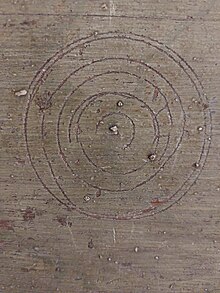
Culross (/ˈkurəs/) is a village and former royal burgh, and parish, in Fife, Scotland.

Delgatie Castle is a castle near Turriff, in Aberdeenshire, Scotland.
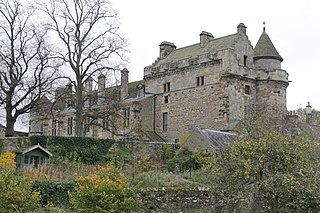
Falkland Palace, in Falkland, Fife, Scotland, is a royal palace of the Scottish Kings. It was one of the favourite places of Mary, Queen of Scots, who took refuge there from political and religious turmoil of her times.

Rossend Castle is a historic building in Burntisland, a town on the south coast of Fife, Scotland.

Alexander Seton, 1st Earl of Dunfermline (1555–1622) was a Scottish lawyer, judge and politician. He served as Lord President of the Court of Session from 1598 to 1604, Lord Chancellor of Scotland from 1604 to 1622 and as a Lord High Commissioner to the Parliament of Scotland.

Kellie Castle is a castle just outside Arncroach and below the dominant hill in the area, Kellie Law. It is about 4 kilometres north of Pittenweem in the East Neuk of Fife, Scotland.
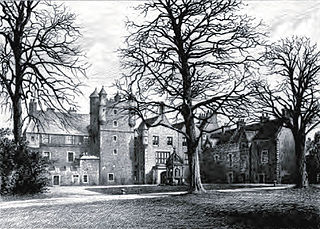
Pinkie House is a historic house, built around a three-storey tower house located in Musselburgh, East Lothian, Scotland. The house dates from the 16th century, was substantially enlarged in the early 17th century, and has been altered several times since. Its location at grid reference NT348726 is to the east of the town centre, on the south side of the High Street. The building now forms part of Loretto School, an independent boarding school. Pinkie House is not far from the site of the disastrous Battle of Pinkie Cleugh, fought in 1547.
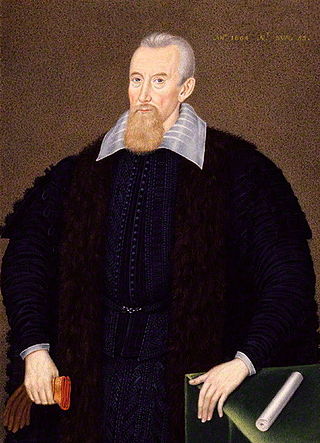
Edward Bruce, 1st Lord Kinloss PC was a Scottish lawyer and judge.
John Clerk of Penicuik (1611–1674) was a Scottish merchant noted for maintaining a comprehensive archive of family papers, now held by the National Archives of Scotland and the National Library of Scotland.

Sir George Bruce of Carnock was a Scottish merchant, ship-owner, and mining engineer.

The Palace of Holyroodhouse, commonly known as Holyrood Palace, is the official residence of the British monarch in Scotland. Located at the bottom of the Royal Mile in Edinburgh, at the opposite end to Edinburgh Castle, Holyrood has served as the principal royal residence in Scotland since the 16th century, and is a setting for state occasions and official entertaining.

Scottish renaissance painted ceilings are decorated ceilings in Scottish houses and castles built between 1540 and 1640. This is a distinctive national style, though there is common ground with similar work elsewhere, especially in France, Spain and Scandinavia. An example in England, at Wickham, Hampshire, was recorded in 1974. There are records of over 100 examples, and a much smaller number of painted ceilings survive in-situ today. Some salvaged painted beams and boards are stored by Historic Environment Scotland. The paintings at Crathes Castle, dating from 1597 and 1602 are probably the best known.

The Renaissance in Scotland was a cultural, intellectual and artistic movement in Scotland, from the late fifteenth century to the beginning of the seventeenth century. It is associated with the pan-European Renaissance that is usually regarded as beginning in Italy in the late fourteenth century and reaching northern Europe as a Northern Renaissance in the fifteenth century. It involved an attempt to revive the principles of the classical era, including humanism, a spirit of scholarly enquiry, scepticism, and concepts of balance and proportion. Since the twentieth century, the uniqueness and unity of the Renaissance has been challenged by historians, but significant changes in Scotland can be seen to have taken place in education, intellectual life, literature, art, architecture, music, science and politics.

Architecture in early modern Scotland encompasses all building within the borders of the kingdom of Scotland, from the early sixteenth century to the mid-eighteenth century. The time period roughly corresponds to the early modern era in Europe, beginning with the Renaissance and Reformation and ending with the start of the Enlightenment and Industrialisation.
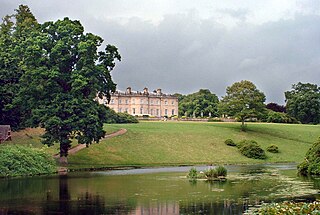
Estate houses in Scotland or Scottish country houses, are large houses usually on landed estates in Scotland. They were built from the sixteenth century, after defensive castles began to be replaced by more comfortable residences for royalty, nobility and local lairds. The origins of Scottish estate houses are in aristocratic emulation of the extensive building and rebuilding of royal residences, beginning with Linlithgow, under the influence of Renaissance architecture. In the 1560s the unique Scottish style of the Scots baronial emerged, which combined features from medieval castles, tower houses, and peel towers with Renaissance plans, in houses designed primarily for residence rather than defence.

Art in early modern Scotland includes all forms of artistic production within the modern borders of Scotland, between the adoption of the Renaissance in the early sixteenth century to the beginnings of the Enlightenment in the mid-eighteenth century.

Gardening in Scotland, the design of planned spaces set aside for the display, cultivation, and enjoyment of plants and other forms of nature in Scotland began in the Middle Ages.
Sir William Nisbet of Dean was a 16th/17th century Scottish merchant who twice served as Provost of Edinburgh from 1616 to 1619 and 1622 to 1623.

Henry Nisbet (1535–1608) was a 16th-century Scottish merchant and Provost of Edinburgh for 1597/98.

Helen Leslie, Lady Newbattle (1520-1594) was a Scottish aristocrat and supporter of Mary, Queen of Scots.


